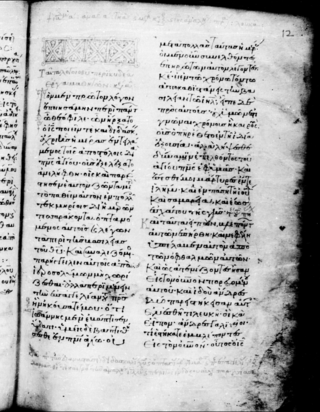
Minuscule 48 (in the Gregory-Aland numbering), A232 (von Soden), is a Greek minuscule manuscript of the New Testament, on parchment leaves. Palaeographically it has been assigned to the 12th century. It has complex contents with some marginalia.

Minuscule 49, ε 155, is a Greek minuscule manuscript of the New Testament, on parchment leaves. Paleographically it has been assigned to the 12th century. It has complex contents and full marginalia.

Minuscule 51, δ 364, is a Greek minuscule manuscript of the New Testament, on parchment leaves. Palaeographically it has been assigned to the 13th century. Formerly it was labelled by 51e for the Gospels, 32a for the Acts, and 38p for the Pauline epistles. It has marginalia.
Minuscule 52, ε 345, is a Greek minuscule manuscript of the New Testament, on parchment leaves. The codex was written in 1285 or 1286. It has complex contents and full marginalia.
Minuscule 53, ε 444, is a Greek minuscule manuscript of the New Testament, on parchment leaves. Palaeographically it has been assigned to the 13th or 14th century. It has marginalia.
Minuscule 54, ε 445, is a Greek minuscule manuscript of the New Testament, on parchment leaves. It is dated by a colophon to the year 1337 or 1338. It has complex contents and marginalia.
Minuscule 55, ε 349, is a Greek minuscule manuscript of the New Testament, on parchment leaves. Palaeographically it has been assigned to the 14th century. The manuscript has complex contents and some marginalia. It was adapted for liturgical use.
Minuscule 83, ε 1218 (Soden), is a Greek minuscule manuscript of the New Testament, on parchment leaves. Palaeographically it has been assigned to the 11th century. It was adapted for liturgical use. It has marginalia.
Minuscule 98, ε 266, is a Greek minuscule manuscript of the New Testament, on parchment leaves. Palaeographically it has been assigned to the 11th century. It has marginalia, it was adapted for liturgical use.
Minuscule 107, ε 344 (Soden), is a Greek minuscule manuscript of the New Testament, on parchment leaves. Palaeographically it has been assigned to the 13th century.
Minuscule 521, ε 443, is a Greek minuscule manuscript of the New Testament, on a parchment. It is dated by a colophon to the year 1321 or 1322. Scrivener labelled it by number 562. The manuscript has complex context.
Minuscule 523, ε 145, is a Greek minuscule manuscript of the New Testament, on a parchment. Palaeographically it has been assigned to the 14th century. Scrivener labelled it by number 489. It was adapted for liturgical use, with full marginalia.
Minuscule 524, ε 265, is a Greek minuscule manuscript of the New Testament, on a parchment. Palaeographically it has been assigned to the 12th century. It was adapted for liturgical use. It has full marginalia.
Minuscule 525, ε 513, is a Greek-Slavic diglot minuscule manuscript of the New Testament, on a parchment. Palaeographically it has been assigned to the 15th century. It has marginalia. Scrivener labelled it by number 491.
Minuscule 526, 610, ε 1127, is a Greek minuscule manuscript of the New Testament, on a parchment, dated to the 11th century.
Minuscule 528, ε 147, is a Greek minuscule manuscript of the New Testament, on a parchment. Palaeographically it has been assigned to the 11th century. Scrivener labelled it by number 483.
Minuscule 529, ε 149, is a Greek minuscule manuscript of the New Testament, on a parchment. Palaeographically it has been assigned to the 12th century. Scrivener labeled it by number 484. It was adapted for liturgical use.
Minuscule 530, ε 151, is a Greek minuscule manuscript of the New Testament, on a parchment. Palaeographically it has been assigned to the 11th century. It has marginalia and was adapted for liturgical use.
Minuscule 557, ε 356, is a Greek minuscule manuscript of the New Testament, on a parchment. Palaeographically it has been assigned to the 13th century. Scrivener labelled it by number 524.
Minuscule 797, ε535, is a Greek minuscule manuscript of the New Testament written on paper. Palaeographically it has been assigned to the 14th century. The manuscript has complex contents.



